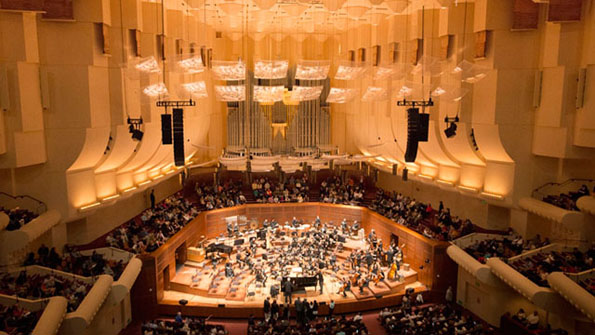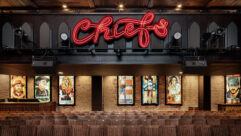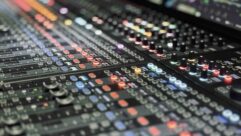
The San Francisco Symphony (SFS) has implemented a new Meyer Sound LEOPARD™ linear sound reinforcement system in its home, Davies Symphony Hall. While highly regarded for the orchestral acoustics, the hall’s warm and reverberant characteristics pose a suite of challenges for its amplified events, which have evolved and diversified under the leadership of Music Director Michael Tilson Thomas. Now with LEOPARD, SFS can offer the same world-class experience it brings to traditional orchestral events to its range of amplified programs, such as film series, pop concerts, Broadway favorites, and leading-edge contemporary music.
“Regardless of content, sound reinforcement should feel natural and undistorted and defined and clear so that you can focus on what is on stage,” says SFS Operations Director Andrew Dubowski. “LEOPARD is an exponential improvement in how we’re able to offer amplified concerts. The system can fool me into thinking the sound is not really amplified, even though I know it is—that feels like magic.”
LEOPARD replaces a central above-stage loudspeaker cluster installed in the 2,743-seat venue in 1992. The new configuration includes twin arrays of 14 LEOPARD line array loudspeakers and three 900-LFC low-frequency control elements per side. The system’s first show was a performance of John Cage’s “Renga” narrated by actor Tim Robbins.
“It’s extremely comfortable and reassuring, in that I’m not getting boxed in by the system and its capabilities when I’m mixing,” says Head Sound Engineer Hal Nishon Soogian. “The system isn’t fighting me. If I need some higher end, it doesn’t get brittle. I use very little EQ on my inputs. I try to pick the correct mic for the correct instrument and do very little to it, so you get no coloration.”
Stage Electrician Jim Jacobs adds: “It’s exciting, after so long trying to solve some of these problems, to have a system that puts sound presence so clearly in every seat.”
The San Francisco Symphony, founded in 1911, presents more than 220 performances annually and reaches an audience of nearly 600,000 through its concerts, education and community programs, media initiatives, and national and international tours.
The newest and smallest member of Meyer Sound’s growing LEO® Family, the patent-pending LEOPARD boasts tremendous power-to-size ratio with ultra-low distortion. Each LEOPARD loudspeaker is optimized for an array of six cabinets or longer, with default low-mid array compensation for utmost simplicity out of the box.
—————
Here, three members of the Davies audio team discuss the new LEOPARD system: how it will be used, and what it can achieve for the San Francisco Symphony and its audience. Taking part in the conversation: SFS Operations Director Andrew Dubowski, Stage Electrician Jim Jacobs, and Head Sound Engineer Hal Nishon Soogian.
What drew the San Francisco Symphony to a LEOPARD system?
Dubowski: Davies Symphony Hall is a very live hall, and it’s easy to overdo amplification. The resonance that feeds back can become a muddy wall of sound. That’s what we aimed to solve by implementing LEOPARD.
What kinds of shows will LEOPARD be used for?
Dubowski: LEOPARD will support any concert that requires amplification, such as our Film Series and holiday concerts or traditional subscription series that feature contemporary composers such as Mason Bates. We are also presenting more artists requiring pop-style amplification like Chris Botti, Pink Martini, and Johnny Mathis.
Is LEOPARD a component in building a new audience?
Dubowski: Absolutely, because we’re focused on what today’s audiences are expecting when they come to a concert, which is different from what they expected 25 or 30 years ago when the hall was first built. We are also presenting programming that we did not have 25 or 30 years ago.
For example, if patrons of the Film Series have bad experiences—the sound is too loud, or they can’t understand the dialogue in a movie—they’re not coming back.
Jacobs: Our old Meyer Sound MSL-3 cluster system was state of the art in 1992. But because many people now have high-quality sound available in their home or car, and Meyer Sound has also taken technology to a new level, the old PA wasn’t competitive anymore; it didn’t give enough presence over the balance of the orchestra.
Line arrays appeared in the mid- or late ‘90s, and they’ve gotten more sophisticated. With a line array, you can deal more specifically with certain reflective qualities and certain zones—with small pieces at a time. You can tailor each one of the 14 loudspeakers on each side to provide a specific quality and detract from certain problem areas for each throw of each loudspeaker.
It’s exciting, after so long trying to solve some of these problems, to have a system that puts sound presence so clearly in every seat.
How did you hit on LEOPARD as the system you wanted here?
Soogian: In addition to the MSL-3 at Davies, we have also used Meyer Sound’s newer MILO system at open-air shows in the Shoreline Amphitheatre to great success. Then more recently, I heard Metallica mixed on a Meyer Sound LEO system. I jokingly said, “That’s great when you’re in a stadium or outdoors. Let me know when you build a rig that fits inside Davies.” At [Music Director] Michael Tilson Thomas’s 70th birthday concert at the beginning of this year, we hung the more compact LYON rig, and it was incredible.
Dubowski: Then LEOPARD was demonstrated in May for performances of John Cage’s “Renga” narrated by actor Tim Robbins. LEOPARD provided excellent clarity for his voice.
Jacobs: We have always liked Meyer Sound systems, and the latest generation has some interesting things in it. The way the drivers are arranged, where they cross, gives them a much wider spread. In this hall, we have the complexities that arise with the use of the acoustic canopy—sightline considerations for film and semi-staged events, and the existing stage lighting positions in Davies—therefore larger systems like LEO or even LYON are too big, and the MINA loudspeakers are a little too small. LEOPARD fills that gap in the Meyer Sound lineup and works beautifully in this hall.
What is it like to mix on LEOPARD?
Soogian: It’s extremely comfortable and reassuring in that, when I’m mixing, I’m not getting boxed in by the system and its capabilities. The system isn’t fighting me. If I need some higher end, it doesn’t get brittle. I use very little EQ on my inputs. I try to pick the correct mic for the correct instrument and do very little to it, so you get no coloration.
How do you define “perfect” in a sound system?
Dubowski: “Perfect” amplification means the sound should not seem amplified. It should sound natural and undistorted and defined and clear so that you can focus on the artists on stage.
LEOPARD can fool me into thinking the sound is not really amplified, even though I know it is—that feels like magic. It’s got a lot of punch. It can rock the hall. But it can also be delicate, and can hold its own.
Having a system that’s state-of-the-art and accurately represents how the orchestra sounds is an exponential improvement in how we’re able to offer amplified concerts.










